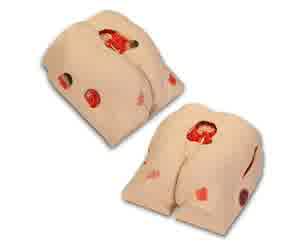- Pin BB 0123456789
- WhatsApp 1234567890
- Line 2345678901
Detail Produk
Redesigned and now made with a new flexible, life-like material that permits the application and easy removal of dressings, without leaving an adhesive residue. Still the most comprehensive model of its kind, molded from a 74-year-old patient, looks and feels like the real thing.
Redesigned and now made with a new flexible, life-like material that permits the application and easy removal of dressings, without leaving an adhesive residue. Still the most comprehensive model of its kind, molded from a 74-year-old patient, looks and feels like the real thing. Displaying the following pressure ulcers* (NPUAP 2007 – National Pressure Ulcer Advisory Panel): Stage I, Stage II, Stage III with undermining, tunneling, subcutaneous fat and slough, deep Stage IV with exposed bones, undermining, tunneling, subcutaneous fat, eschar and slough. Also shown are a suspected DTI (Deep Tissue Injury), unstageable full eschar/slough wound, and a 5 1/2” dehisced wound. The Stage III and Stage IV are positioned so that a “bridging” dressing for use with a vacuum assisted closure and negative pressure wound therapy devices can be demonstrated and practiced. Wound assessment has become critical to the operation of health agencies, as inaccurate wound assessment can affect reimbursement, cause inaccurate reporting of patient outcomes and the appearance of potential adverse events. This model makes it possible to visualize and understand the differences in wounds. Once the different etiologies are understood, you can discuss and devise treatment plans that will deliver optimized patient care. Great care has been taken to color each wound just as you would see it on a patient. You are able to demonstrate and practice wound cleansing, classification, staging, and assessment, as well as the measurement of wound length, depth, undermining, and tunneling. The positioning of the wounds permits multiple dressings to be demonstrated at the same time. Size: 12” x 13 1/2” x 6” Sh. wt. 6.0 lbs.
Tidak ada produk berkaitan.
Tidak ada produk popular.



